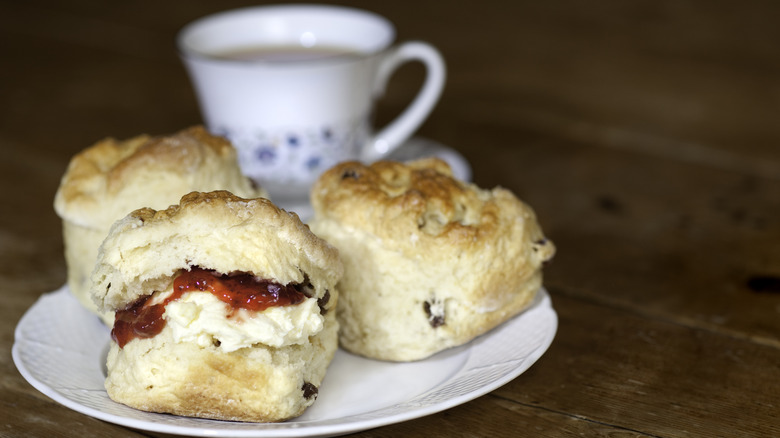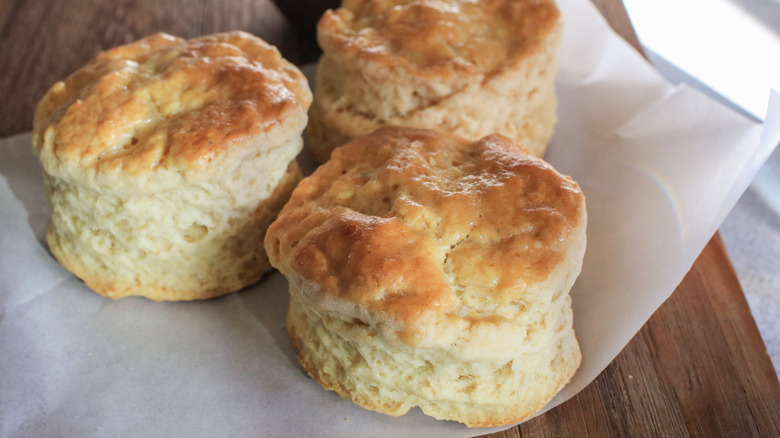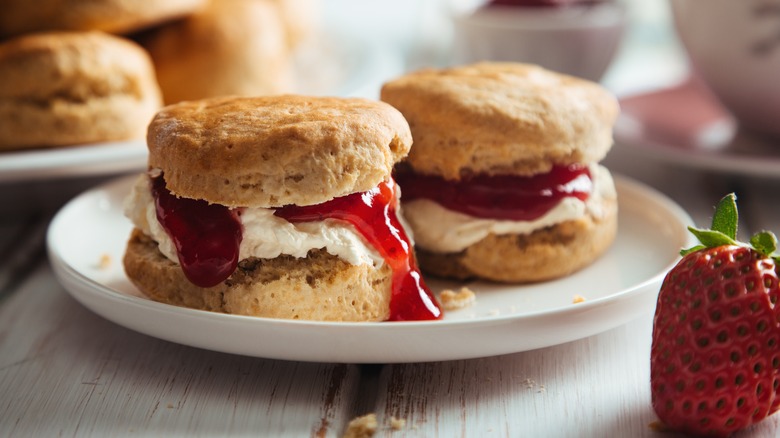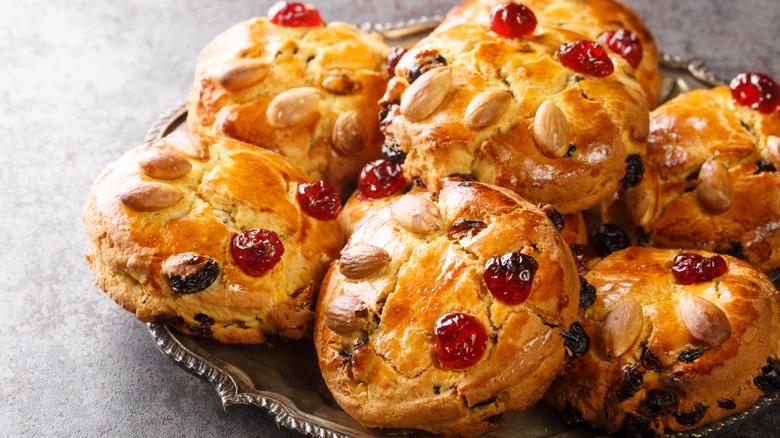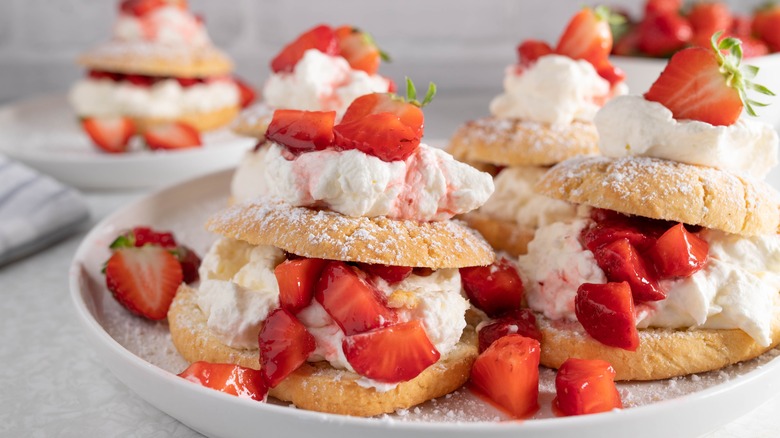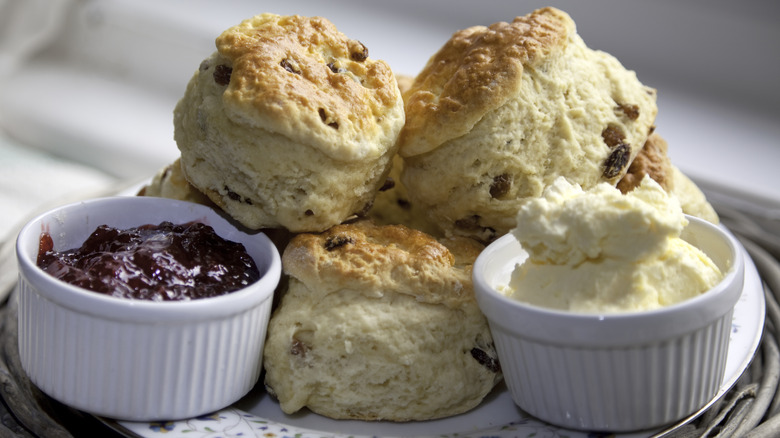The Difference Between Cream And Butter Scones Goes Beyond The Dairy
Melding elements of a pastry, cookie, and a biscuit, scones are a distinct baked good type. They rely on only a few accessible ingredients — flour, sugar, and a milk-based fat — to craft a food with a perfect, soft crumble. Plus, they're a great canvas for further ingredients, lending interpretations like a savory feta and cheese scone, or a perfect blueberry scone.
In addition to the varying flavorings, scones take on different renditions by altering the utilized dough, too. Modifications in the selection of ingredients lead to noticeable differences in flavor and texture. Such a discrepancy is especially showcased when swapping between a butter and cream base.
Cream scones have a delectable soft consistency with a delicate crumble. They lie a little closer to a cookie-like texture and are typically enjoyed sans filling. Conversely, butter scones are a more classic interpretation, with a crumbly feel and a robust texture. Their heftier consistency is the go-to scone construction, ready for a range of interpretations.
What are cream scones?
Cream scones follow a straightforward recipe. All that's necessary to craft a batch of these delectable creations is flour, sugar, salt, and a leavening agent like baking powder. Not a lot of cream goes into a batch — only a few tablespoons — for fear the pastry turns out too sticky. The dairy component adds a tad of sweetness but retains a gentle flavor. And the interior texture is a delight — delicate, soft, and moist. When prepared properly, these baked goods don't even need a topping, so there is no need for the cream or jam first debate.
The use of cream in lieu of butter also aids assembly. The temperature of melted butter worsens dough quality, and it requires some manual work to mix in cold butter chunks. It's much easier to keep cream chilled, yet still liquid, before integration, making cream scones an easier choice for first-time bakers. And to further improve the texture of the scone, enhance the dough's rise by throwing it into the freezer.
What are butter scones?
Delicious butter scones are a widespread method of preparation, often referred to as the classic English scone. The dough comes together with flour, milk, sugar, salt, some baking powder and the eponymous dairy component. Eggs are a contentious yet frequent ingredient in butter scones, a more newfound addition absent in earlier versions. Their inclusion adds a bit more structure and flavor, which can further butter scones' denser texture.
The dry ingredients are mixed together first, followed by the tricky integration of butter. Both overworking the dough and the warming of butter leads to an unsavory scone, so bakers take on different tactics. Some carefully mix chunks of butter with their hands, while others grate frozen butter for more convenient integration.
The result is a more robust and crumbly scone with a beautiful crisp. These versions tend to be less moist — but not to a fault — making them the ideal pastry to pair with cream and jam.
Sturdier butter scones are better equipped for heftier fillings
With their delicate and fragile nature, cream scones aren't the ideal dough for fillings. The pastry can be flavored with spices like cinnamon, nutmeg, and allspice, but it's not the best vessel for other ingredients. On the contrary, the sturdier nature of butter scones makes them the preferred option for all of the creative ingredient combinations.
Dried fruit is a classic addition — raisins, apricots, dates, and cranberries are all excellent candidates. Others also mix in nuts, from pistachios to cinnamon almond scones, with the sturdy dough easily withstanding such solid components.
Butter scone's texture and flavor also make them the go-to for savory scone renditions. Pack in the elements of a good breakfast with a ham, cheese, and scallion scone, or go Mediterranean with a pine nut, sundried tomato, and basil-loaded tomato pesto scone. Such a multi-ingredient assembly is best suited to the butter base, which is why it's the go-to for most scone recipes.
Lighter cream scones can be turned into shortcake
Cream scones' light and airy texture enables for crossovers with other baked goods. The dough can be reformed into a shortcake with a few tweaks. It's necessary to add more eggs and sugar into a similar batter, molded into a larger shape. Rather than a baked good served individually, this cake-like creation can be beautifully garnished with fruit, whipped cream, and other various toppings.
While a strawberry shortcake doesn't immediately allude to a scone, the two baked goods do share common attributes. First of all, some consider scones a type of shortcake. Plus, bakers can use a cream-based dough to make interpretations that sit halfway in between, taking on elements of both scone and shortcake. The dough's malleable nature allows for baked goods that defy categorization. So, reach for cream to open up pastry experimentation. Lean into the more delicate texture of cake-like creations without losing the ease and durability of scones.
Mix and match both butter and cream into scones
Although there's merit in sticking to butter or cream exclusively, many interpretations integrate both. Scone recipes come in many forms, so execute different renditions to come to a personal favorite.
Adding cream and butter together creates a scone with elements of both styles. There's a little less richness than with a solely cream recipe, but the pastry's more flavored and less dry than some butter varieties. Some also add milk to the mix to dilute the ingredients, while others stick to the fat-heavy dairy components.
There's also the buttermilk scone to consider. This version adds a tang and creates an extra fluffy texture by activating gas through the bonding of buttermilk and baking powder. Most frequently, buttermilk scones are made with butter, but some mix in cream, too.
And if you're struggling to pick between the two varieties, cream and butter scones are similar enough for a direct substitution. So, simultaneously make a batch of each type and taste which scones suit your fancy. Regardless of the preferred interpretation, you'll have a delicious, crumbly pastry ready for a tea break.
